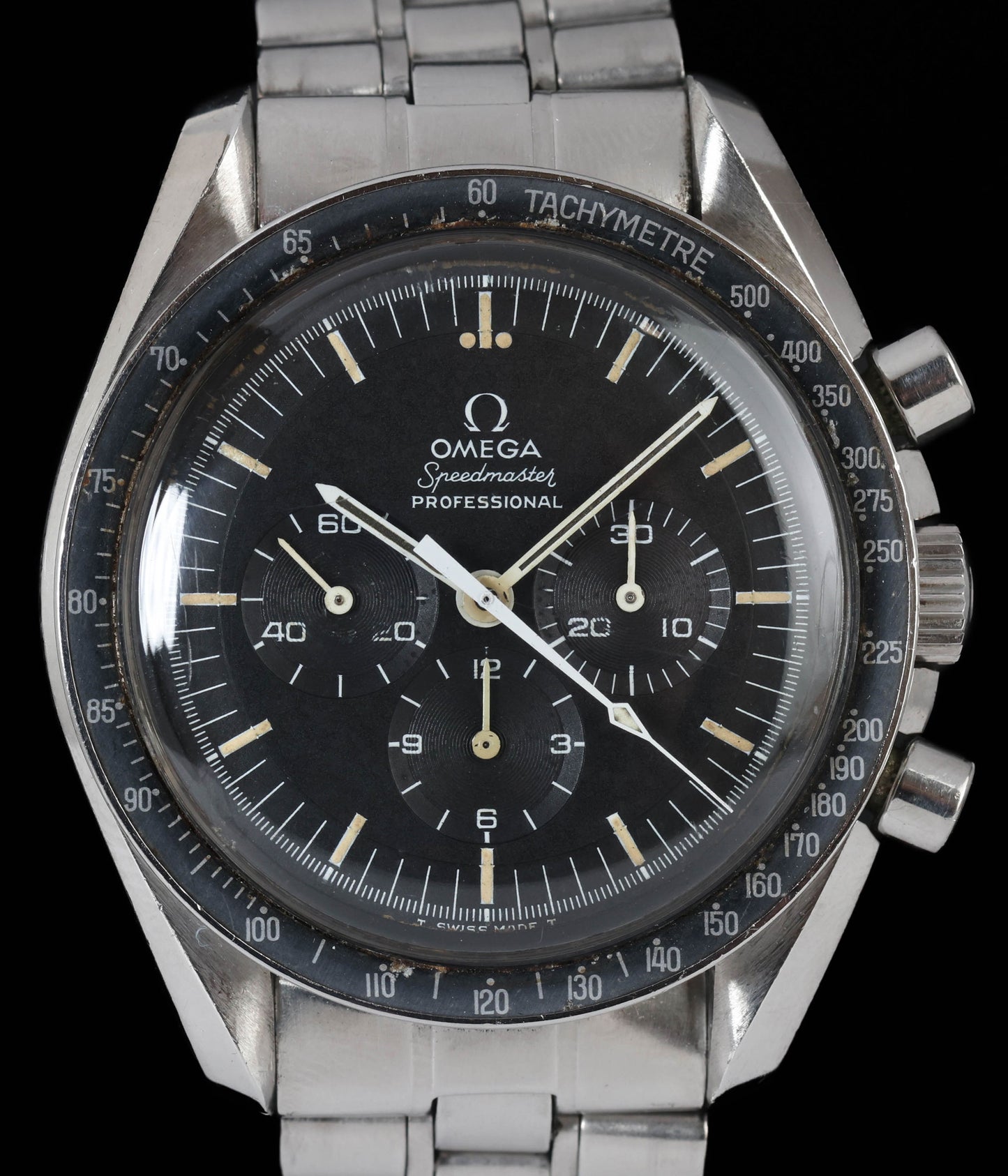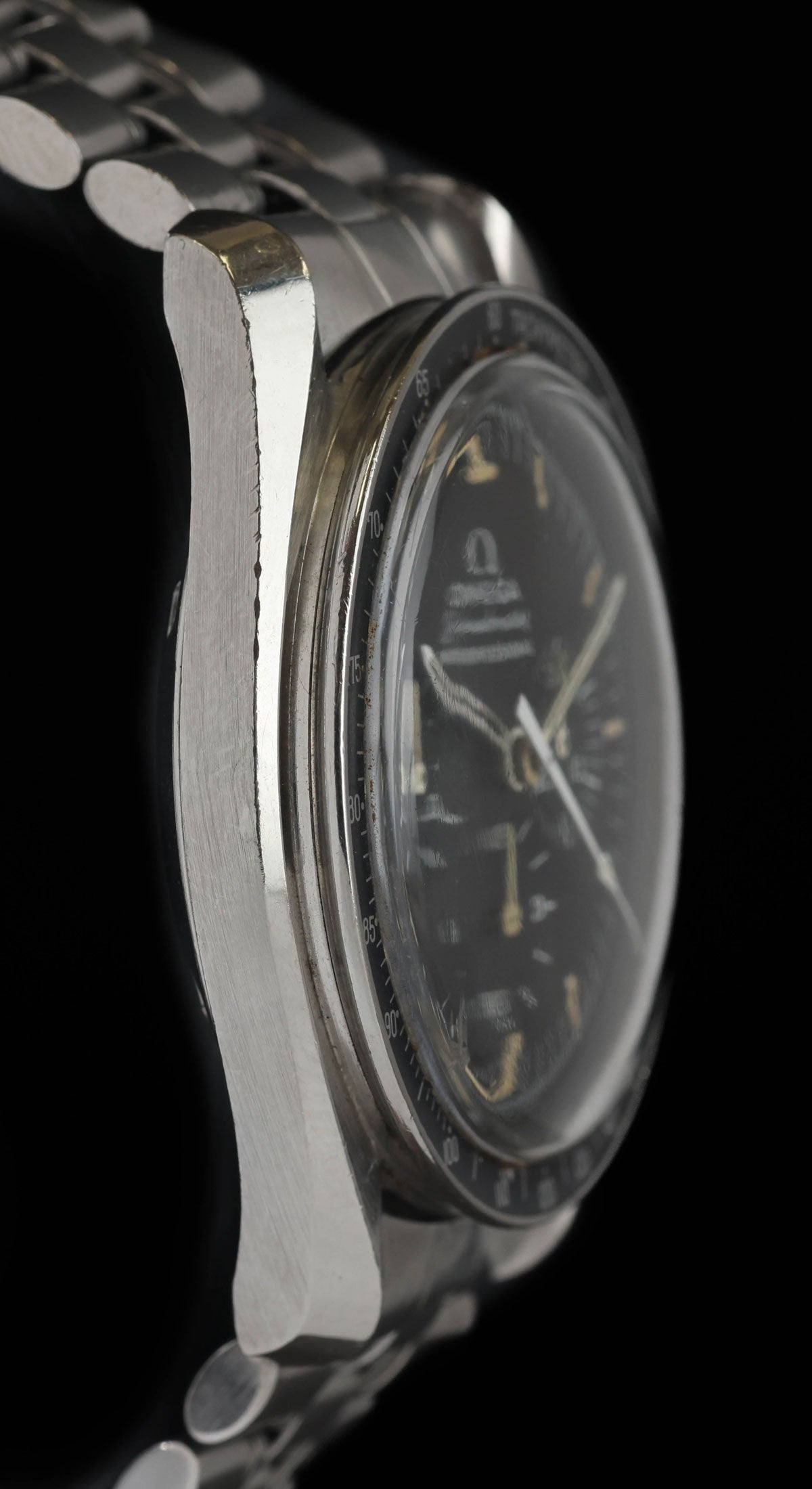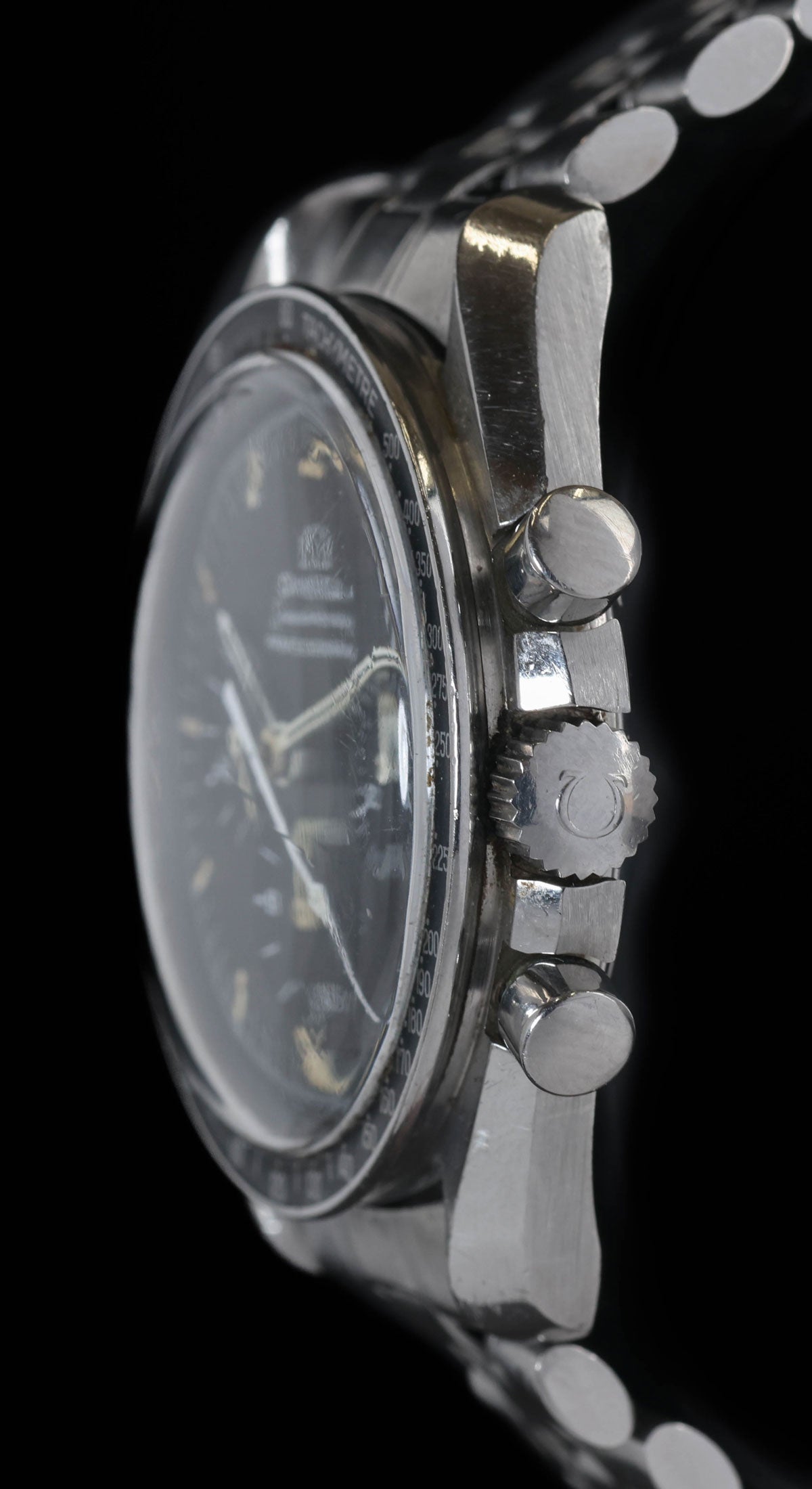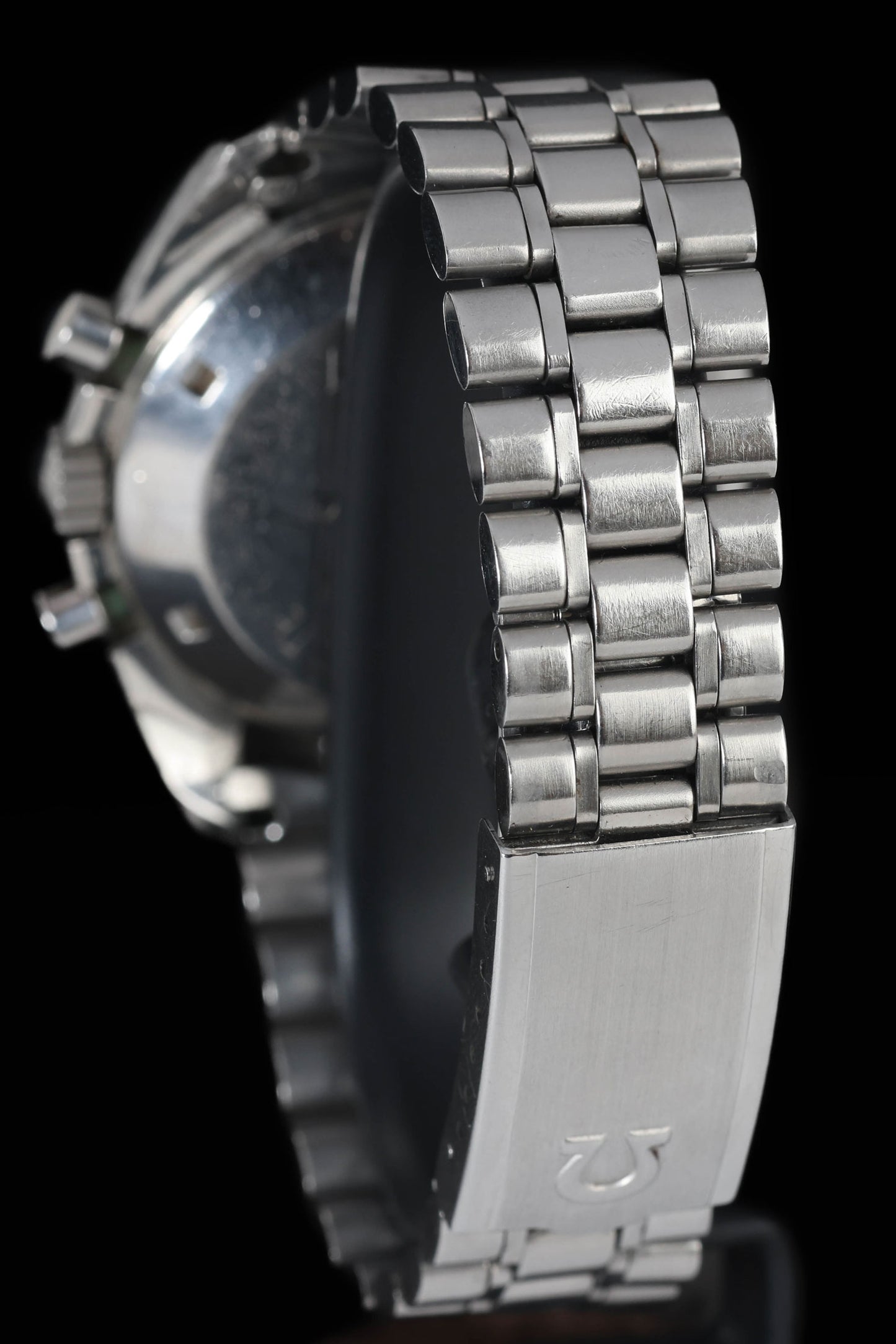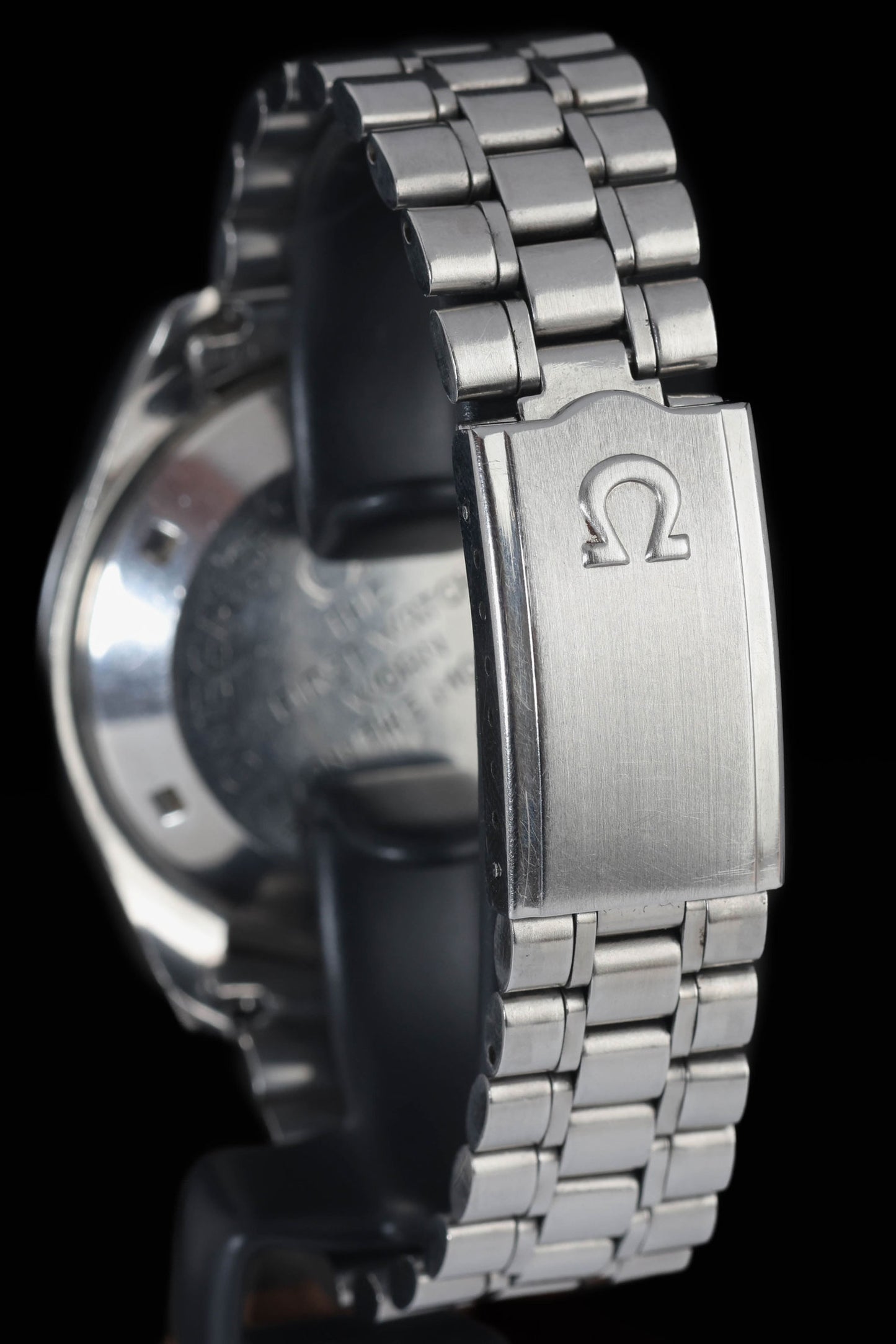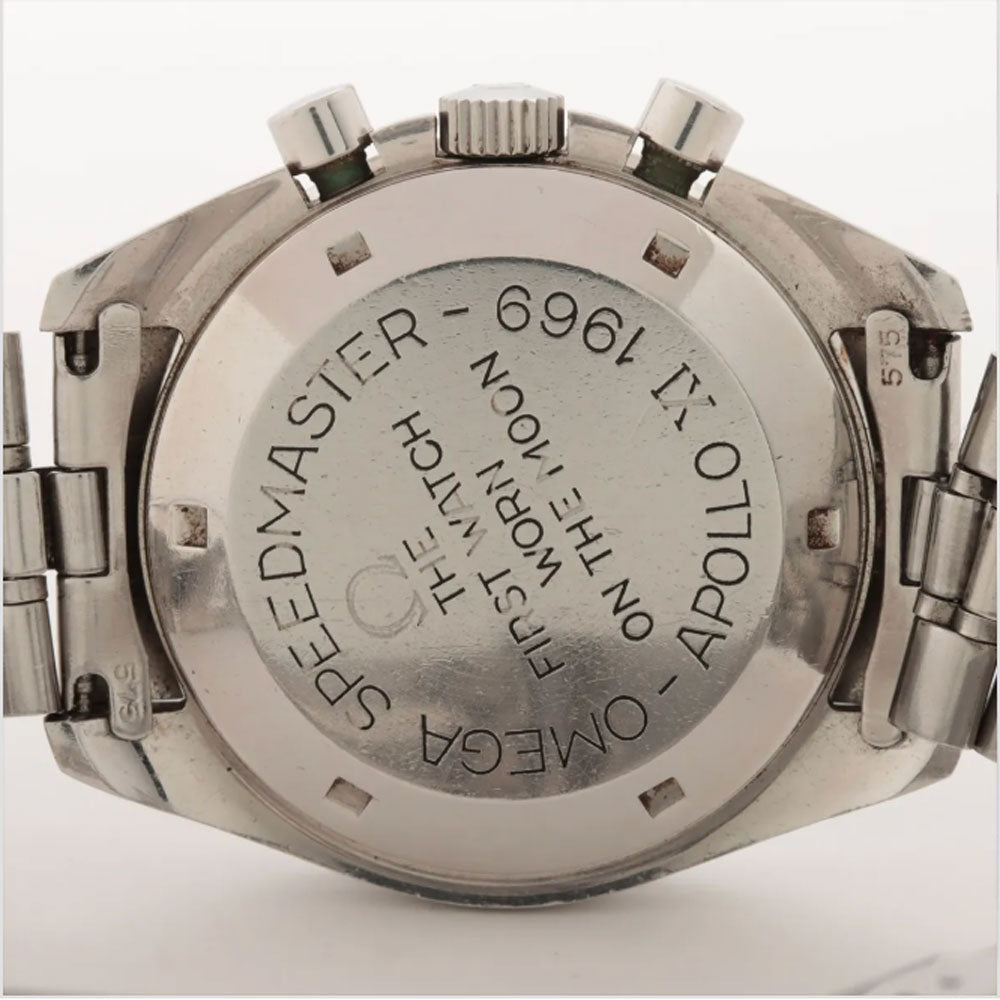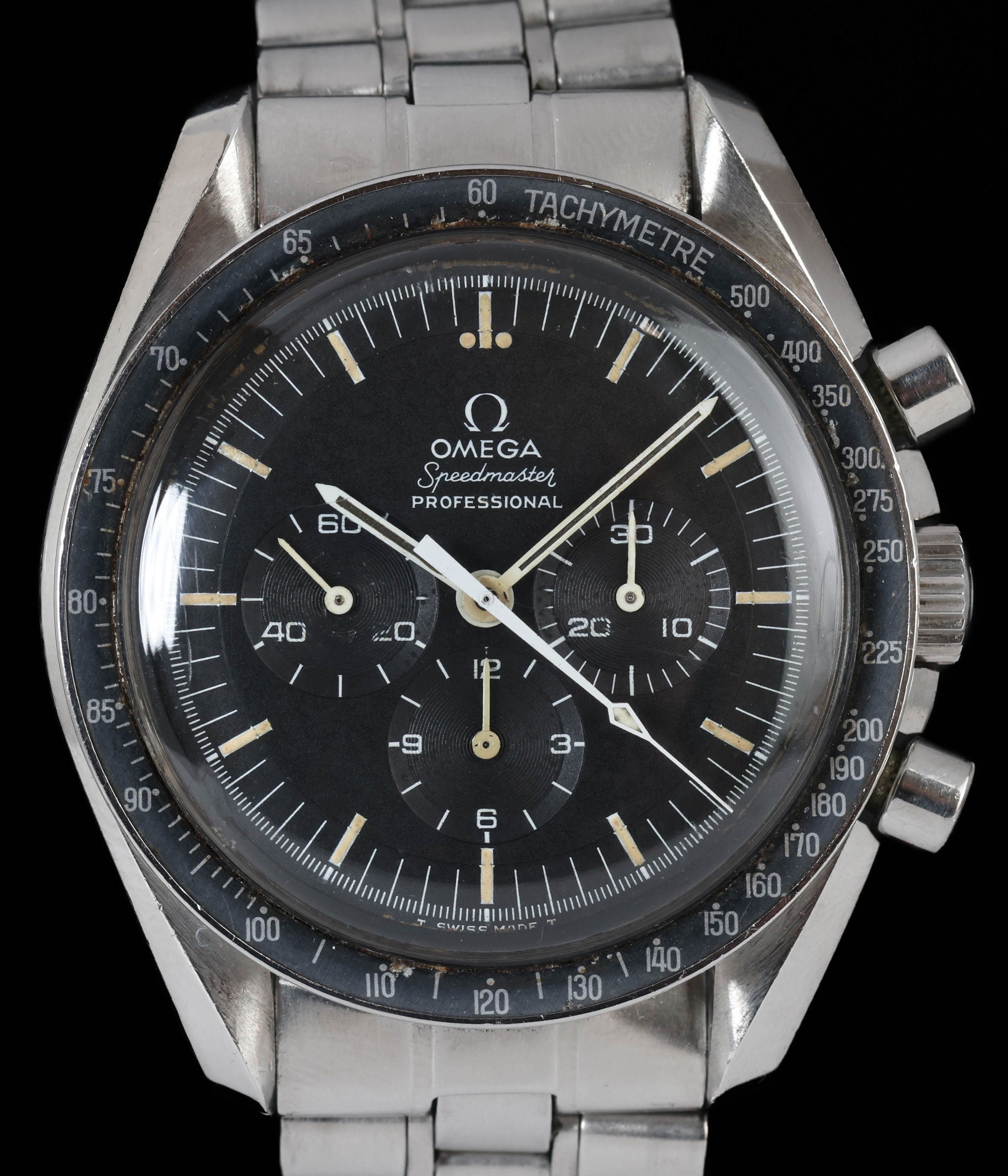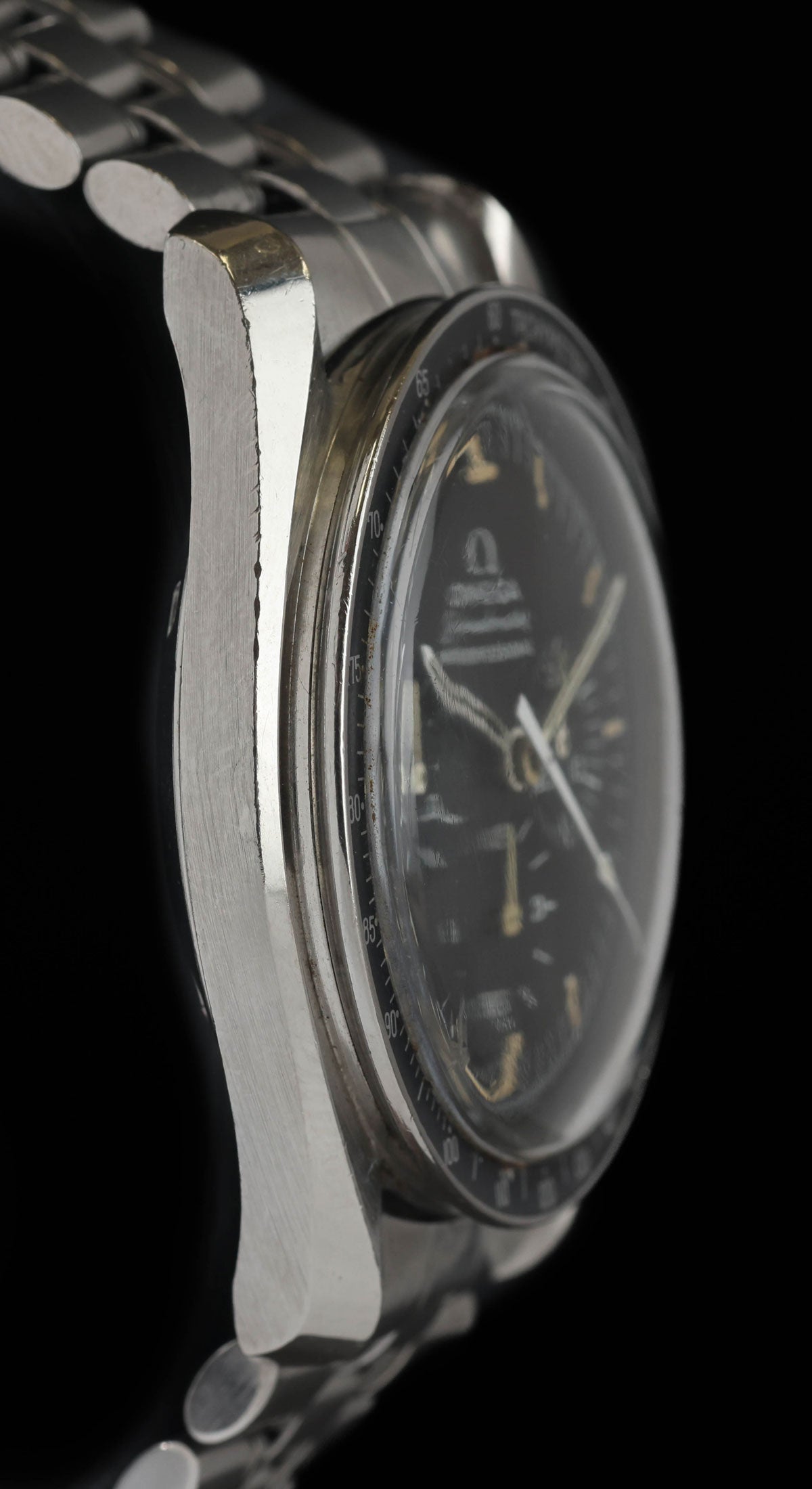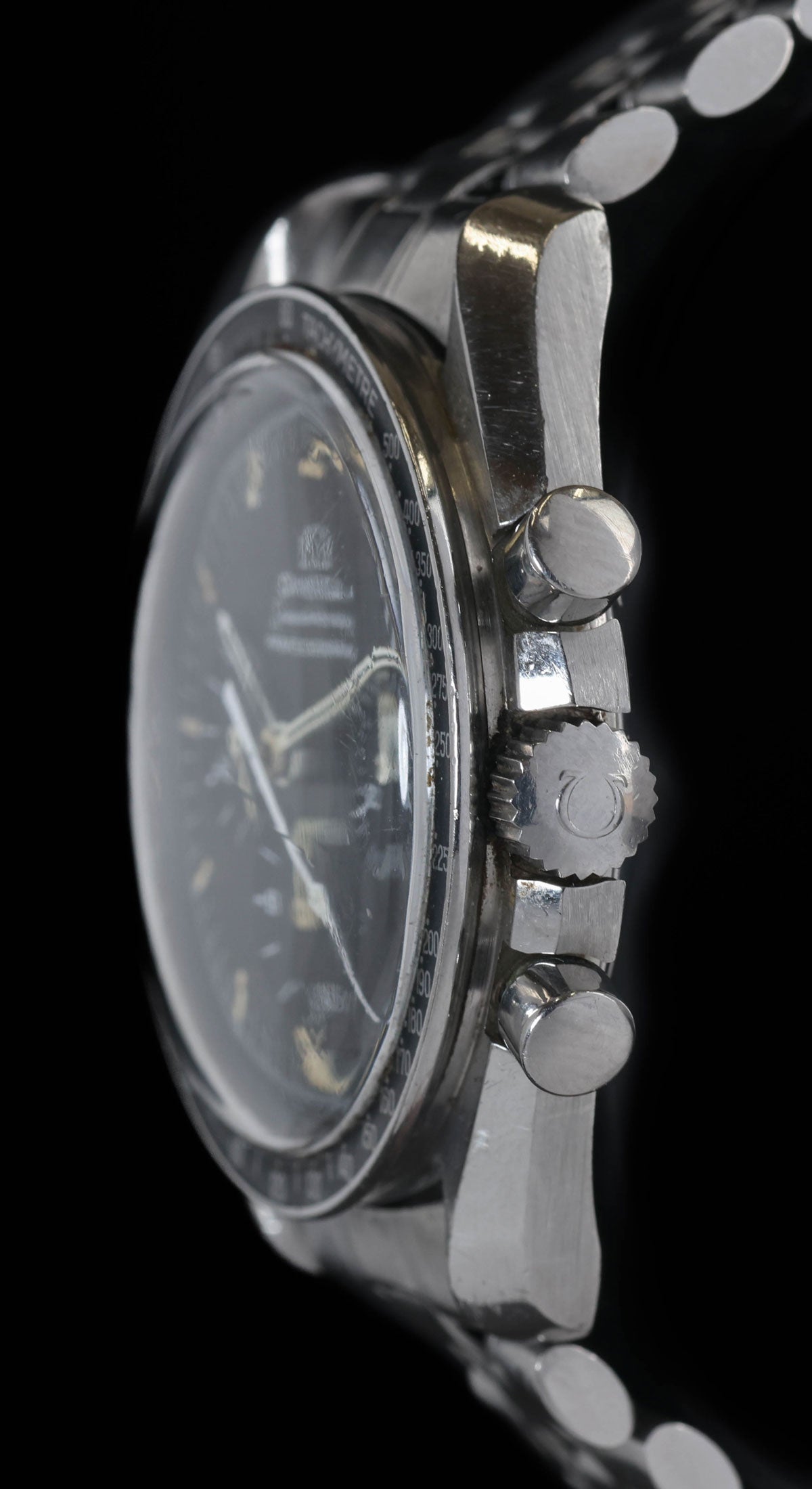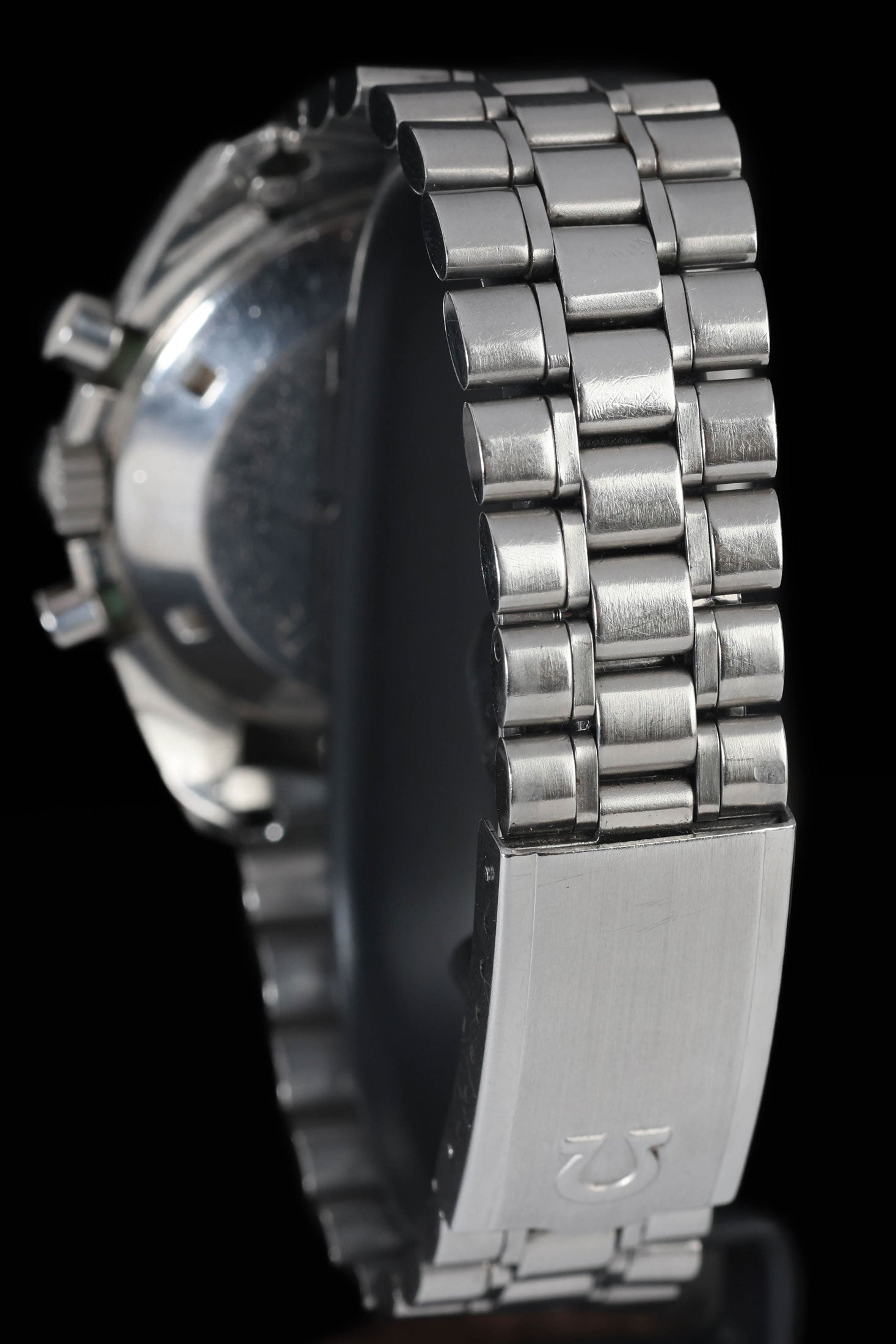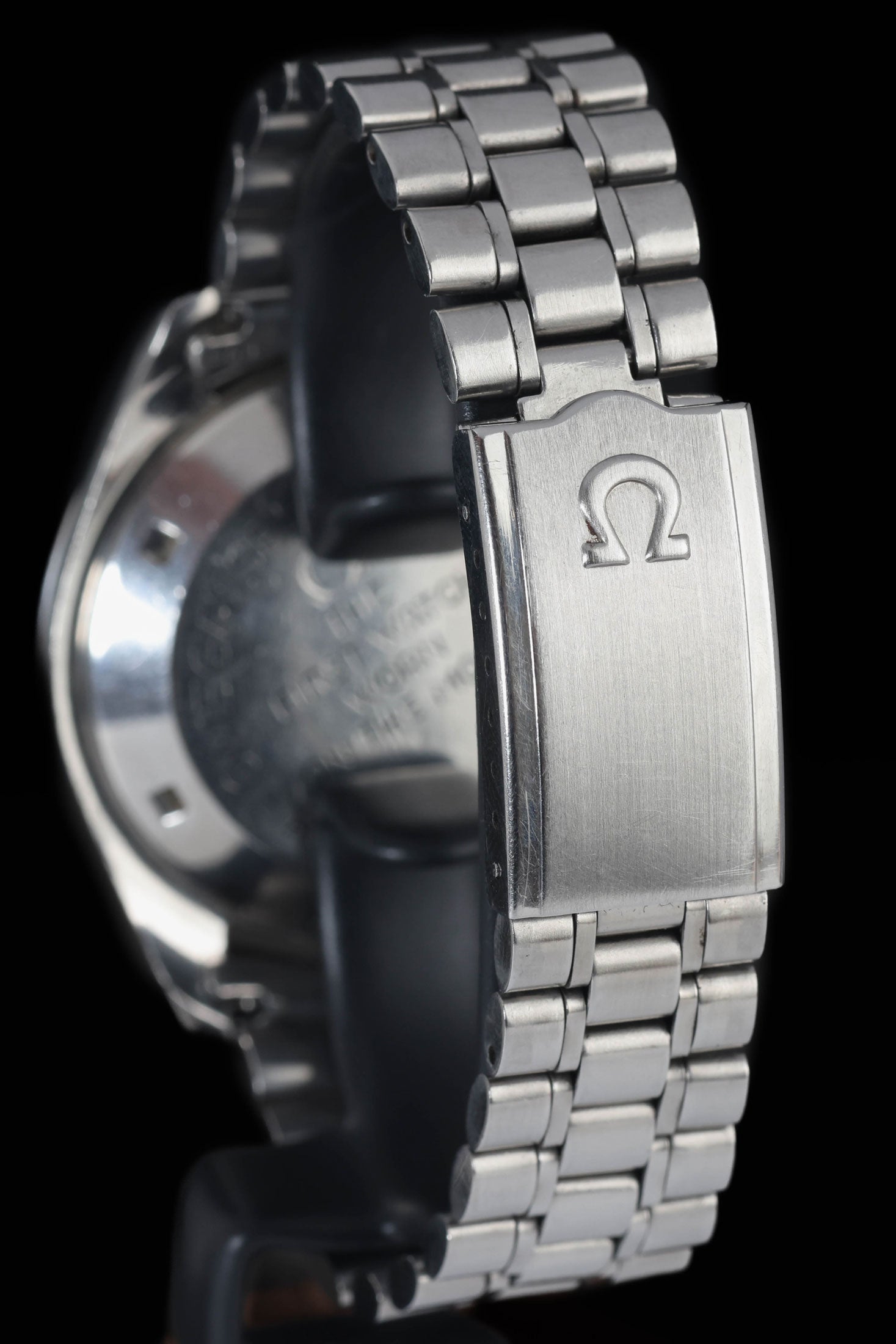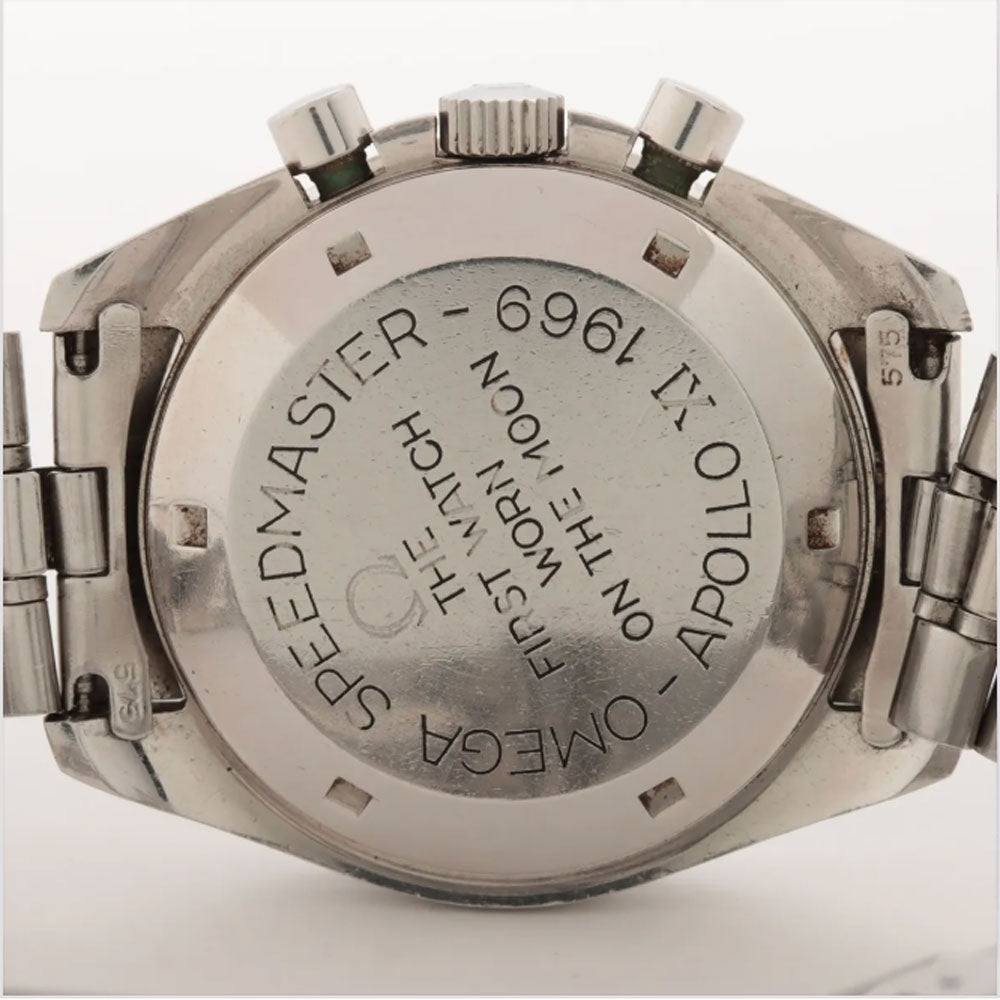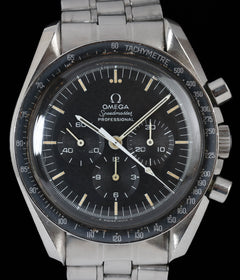Crown Vintage
Omega Speedmaster 145.022-69ST 42mm Circa 1971
Omega Speedmaster 145.022-69ST 42mm Circa 1971
Couldn't load pickup availability
Omega Speedmaster 145.022-69ST
The case and bracelet are in good vintage condition, showing expected wear for a watch of this age. Scratches are visible on the case flanks, lugs, and bracelet surfaces, but the original contours remain well-defined. The bracelet is the rare 1116/575. The Hesalite crystal has light surface marks, typical for vintage Speedmasters and purely cosmetic. The dial has developed an attractive creamy patina across the tritium hour markers, with lume showing light, even oxidation. Hands are in good condition, with minor ageing consistent with the rest of the watch.
Importantly, the caseback is the rare Japan-only variant produced between 1970 and 1971, engraved with “OMEGA SPEEDMASTER – APOLLO XI 1969 – THE FIRST WATCH WORN ON THE MOON.” This version was issued exclusively for the Japanese domestic market and is highly sought after by collectors for its regional specificity and short production window. A well-preserved example of a historically significant reference, featuring one of the most distinctive and uncommon caseback variants in the Speedmaster lineage.
Share
Why we love this watch
Why we love this watch
Omega Speedmaster 145.022-69ST: Where the Moonwatch Became a Legend
Produced from late 1969 to around 1971, the 145.022-69 bridged the gap between Omega’s era-defining calibre 321 and the newly introduced calibre 861. It also introduced subtle but defining design tweaks that transformed the Speedmaster from a spacefaring tool into a cultural icon.
Today, the 145.022-69ST is a standout reference not because it was the first on the Moon—that honour belongs to the 105.012—but because it was the first to be sold with full knowledge of where the Speedmaster had just been. It represents the start of the Moonwatch mythos being baked into Omega’s production, not just its marketing.
The Calibre 861: A New Heartbeat
Earlier Speedmasters, including the 105.003 and 145.012, used the column-wheel controlled calibre 321. Renowned for its beauty and mechanical complexity, it was also expensive and time-consuming to produce. In 1968, Omega introduced the calibre 861—a cam-actuated chronograph movement beating at 21,600 vibrations per hour, offering improved reliability, more efficient manufacturing, and better long-term serviceability.
The 145.022 was the first reference to use the 861, and the -69ST iteration was the second production run of that design. For all its modernity, the 861 still shared the same Lemania base architecture as its predecessor, and Omega carefully tuned it to high accuracy standards. This was no downgrade—it was a recalibration of what a professional chronograph could be in the late 1960s.
Case Design and Materials
The case of the 145.022-69ST retained the classic asymmetrical 42mm shape with twisted lyre lugs, integrated crown guards, and a pronounced tool-watch feel. Made from stainless steel—reflected in the ‘ST’ suffix—the case used a single-piece construction with a brushed top surface and polished flanks. The lug width remained 20mm, and the domed Hesalite crystal lent a warm distortion at the dial’s edge that modern sapphire Speedmasters often lack.
Dial Design: Stepped and Sublime
The dial of the 145.022-69ST continued the professional layout introduced in the 1960s. Early examples used a stepped matte black dial with an applied metal Omega logo, a carryover from the 321-era references. Later in production, Omega transitioned to printed logos and, eventually, a flat dial without the step.
The dial featured recessed sub-dials at 3, 6, and 9 o’clock, white painted baton hands, and tritium lume plots at each hour marker. Over time, this lume has aged into a range of tones—from pale vanilla to rich pumpkin—giving each watch a unique fingerprint of age. The long white chronograph seconds hand and simple typography keep the overall aesthetic balanced and legible, even decades on.
Caseback Variations: A Snapshot of an Era
One of the most fascinating aspects of the 145.022-69ST is the range of caseback inscriptions found across production batches. These casebacks reflect a moment of transition, not just mechanically, but culturally—when Omega began positioning the Speedmaster as more than just a chronograph and firmly embraced its Moonwatch identity.
There are four primary caseback types associated with the 145.022-69ST:
- Smooth Caseback (Pre-Moon): Some of the earliest examples were produced with plain casebacks, free from inscriptions. These are typically seen on watches assembled in 1969 but produced before Omega finalised its post-Apollo XI caseback design. These “Pre-Moon” casebacks are a nod to the 145.022-68 and earlier Speedmasters.
- Standard Moonwatch Engraving: Most 145.022-69s feature the now-classic dual inscription: “FLIGHT-QUALIFIED BY NASA FOR ALL MANNED SPACE MISSIONS” along the top perimeter, and “THE FIRST WATCH WORN ON THE MOON” along the bottom. This layout would become the standard Moonwatch caseback design from this point forward, and remains in use on modern Speedmaster Professionals today.
- Apollo XI Commemorative Variant (Japan-Only, 1970–1971): Perhaps the most distinctive and elusive of the caseback variants is found on this watch and it is the version produced specifically for the Japanese domestic market in 1971. These examples feature a unique engraving that reads:
“OMEGA SPEEDMASTER – APOLLO XI 1969 – THE FIRST WATCH WORN ON THE MOON”
Unlike the standard caseback, this layout omits the NASA flight qualification line entirely and places the Apollo XI tribute front and centre. These casebacks were issued shortly after the Moon produced in 1971 and sold in 1972 in Japan only. While the rest of the watch is functionally identical to other 145.022-69ST models, this caseback variant stands apart for its regional specificity and short production run.
It’s believed these were offered either through Omega’s Japanese distributor or in conjunction with a targeted marketing campaign to commemorate the Moon landing. They were not limited or numbered editions in the modern sense, but their production window was narrow—likely no more than a year—which makes surviving examples quite rare today. They are immediately identifiable and highly sought after by collectors for their blend of mainstream reference and local-market uniqueness.
All original 145.022-69 casebacks are of the single-step type with a shallow circular bevel and vertical brushing. The variety of caseback engravings—especially the rare Japan-only Apollo XI version produced during 1970–1971—adds a layer of nuance to the reference. It also underscores Omega’s early understanding that the Moonwatch story had both global reach and regional resonance.
From Astronauts to Enthusiasts
While the 145.022-69ST was not the first Speedmaster to leave Earth, it was the first to fully embrace that heritage on its caseback. It marked the moment Omega leaned into its new identity—no longer just a supplier of professional chronographs, but the creator of the Moonwatch. The reference stands as a turning point, where the Speedmaster transitioned from silent workhorse to outspoken legend.
Collectors are drawn to it not only for its place in the lineage, but also for its aesthetic sweet spot. It retains the stepped dial, DON bezel, and tritium lume of earlier models while offering the reliability and serviceability of the calibre 861. And in rare cases, the Japanese-market caseback offers an added layer of intrigue and rarity that goes beyond the usual collector talking points.
Final Thoughts
The Omega Speedmaster 145.022-69ST occupies a unique and influential chapter in the brand’s history. It is where the Moonwatch story shifted gears—where NASA flight qualification gave way to broader cultural resonance, and Omega’s engineering legacy met international fascination with space.
From its transitional movement and classic design language to its highly collectible caseback variants, the 145.022-69ST continues to reward those who look closely. Whether it’s your first foray into vintage Omega or the cornerstone of a deeper collection, this reference stands out—not as a footnote to Apollo, but as the moment the legend came home.
Case & Bracelet
Case & Bracelet
The case and bracelet is in good vintage condition. Scratches visible on case and bracelet. Crystal has light scratches. Caseback is the rare Japan only caseback produced between 1970-71.
Dial & Hands
Dial & Hands
Good vintage condition. Nice creamy patina on dial. Hands in good condition. Light oxidation of lume.
Warranty & Condition
Warranty & Condition
Crown Vintage Watches provides a minimum 3-month mechanical warranty on pre-owned watches, from the date of purchase.
The warranty covers mechanical defects only.
The warranty does not cover damages such as scratches, finish, crystals, glass, straps (leather, fabric or rubber damage due to wear and tear), damage resulting from wear under conditions exceeding the watch manufacturer’s water resistance limitations, and damage due to physical and or accidental abuse.
Please note, water resistance is neither tested nor guaranteed.
Shipping and insurance costs for warranty returns to us must be covered by the customer. Returns must be shipped via traceable courier. Return shipment must be pre-paid and fully insured. Collect shipping will be refused. In case of loss or damages, the customer is liable.
Our Pledge
At Crown Vintage Watches, we stand by the authenticity of every product we sell. For added peace of mind, customers are welcome to have items independently authenticated at their own expense.
Condition
Due to the nature of vintage timepieces, all watches are sold as is. We will accurately describe the current condition and working order of all watches we sell to the best of our ability.
Shipping & Refund
Shipping & Refund
